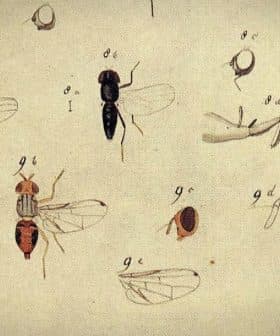Study Shows Potential Health Benefits of Hydroxytyrosol in Olive Oil
New research has shown that hydroxytyrosol, a phenolic compound found in extra virgin olive oil, can significantly reduce oxidation levels of LDL cholesterol, potentially improving cardiovascular health. The study also found that hydroxytyrosol intake affects extracellular vesicles and miRNAs, which could have significant implications for intercellular signaling pathways related to health and disease, particularly in neurodegenerative conditions. Researchers caution that more studies are needed to fully understand the long-term implications and exact mechanisms of hydroxytyrosol’s impact on human health.
New research sheds new light on the potential impact on human health of hydroxytyrosol, one of the main phenolic compounds found in extra virgin olive oil.
The study confirmed, among other findings, that hydroxytyrosol significantly reduces the oxidation levels of LDL cholesterol (the so-called ‘bad cholesterol’), thus potentially improving cardiovascular health and reducing associated risks.
“Some extra virgin olive oil phenols contain precursors of this molecule. Once we consume extra virgin olive oil, our body reacts by producing hydroxytyrosol,” study co-author María-Carmen López de las Hazas told Olive Oil Times.
The potency of hydroxytyrosol as an antioxidant creates an antioxidant-rich environment in the plasma, protecting LDL from oxidative stress.
López is a researcher at the Laboratory of Epigenetics of Lipid Metabolism at the Research Institute on Food and Health Sciences (IMDEA) in Madrid.
The study involved a clinical trial during which 12 healthy participants received first a single 25-milligram dose of hydroxytyrosol, followed by a daily dose of 25 milligrams of hydroxytyrosol for one week.
The researchers documented a measurable decrease in oxidized LDL (oxLDL) levels following one week of daily hydroxytyrosol intake.
See Also:Health NewsReducing oxLDL is crucial as it plays a key role in developing atherosclerosis and cardiovascular diseases.
“We observed notable reductions in LDL oxidation after just one week, which surprised us because we initially believed it would take much longer to see any effect,” Alberto Dávalos, an IMDEA researcher and head of the project, explained.
“The potency of hydroxytyrosol as an antioxidant creates an antioxidant-rich environment in the plasma, protecting LDL from oxidative stress,” he added.
The researchers focused on extracellular vesicles to better understand the mechanisms behind hydroxytyrosol’s antioxidant activity. These vesicles are small molecules secreted by cells and circulate throughout the body, carrying substances and messages to other cells and tissues.
“We call them the cellular WhatsApp. They are small lipid-bound vesicles secreted by cells across all kingdoms of life, serving as critical communication vehicles between cells,” López and Dávalos explained.
Extracellular vesicles transport various biological molecules, including proteins, lipids and nucleic acids like microRNAs (miRNAs), influencing physiological processes and intercellular communication.
The research showed that hydroxytyrosol intake increases extracellular vesicle secretion and modulates their size and cargo potential, significantly impacting intercellular signaling pathways related to health and disease.
Additionally, researchers found that hydroxytyrosol intake affects miRNAs transported within extracellular vesicles. Micro ribonucleic acid molecules (miRNAs) are essential for regulating gene expression by determining the amount of protein produced from a gene.
miRNAs are involved in various physiological processes, including inflammation and cardiovascular health, and may protect against certain cancers and neurodegenerative conditions.
According to the researchers, hydroxytyrosol intake induced notable changes in the activity of specific miRNAs, with some becoming more active and others less active.
“miRNA-124, typically elevated in cardiovascular complications, was significantly decreased, which is beneficial,” López and Dávalos noted.
“Conversely, miRNA-590, important for heart repair after myocardial infarction, increased, indicating potential cardioprotective effects,” they explained.
“These miRNAs might serve as biomarkers or therapeutic targets, highlighting the promising impact of hydroxytyrosol,” the researchers emphasized.
“However, the long-term implications and exact mechanisms still need clarification through extended studies,” they cautioned.
Hydroxytyrosol’s potential impact on human health is also related to some unique properties researchers are exploring, especially its ability to cross the blood-brain barrier.
“Something relevant about hydroxytyrosol is that this is one of the few phenolic compounds that can be found in the brain, at least in several animal models,” Dávalos noted.
See Also:Hydroxytyrosol May Help Prevent Colon Cancer Spread, New Research Suggests“Normal polyphenols cannot transport through the blood-brain barrier unless they have a transporter or a specific chemical structure. One possibility for how they cross the barrier is transport within extracellular vesicles,” he explained.
The blood-brain barrier is composed of highly specialized cells lining brain vessels. It serves as a protective shield that prevents bacteria, viruses and other potentially harmful molecules from accessing the brain. The barrier also regulates the entry of nutrients and other crucial substances.
According to the researchers, this discovery could have significant implications if future studies confirm that hydroxytyrosol is transported via extracellular vesicles in a larger population.
“This is relevant from a dietary point of view because when you consume polyphenol-rich extra virgin olive oil, a certain amount of hydroxytyrosol can be incorporated within extracellular vesicles, increasing its potential to cross the blood-brain barrier,” Dávalos explained.
“This mechanism opens exciting therapeutic possibilities, particularly regarding neurodegenerative diseases,” the researchers pointed out.
Still, the scientists emphasized that additional studies are necessary to thoroughly understand this cellular behavior and its implications.
“It is potentially a positive result to see hydroxytyrosol crossing the barrier, but increased permeability to beneficial substances transported in extracellular vesicles could also imply increased vulnerability to other compounds,” Dávalos warned.
“Additionally, if the blood-brain barrier is permeable enough to allow hydroxytyrosol through, other barriers like the placental barrier might also be crossed when transported in extracellular vesicles. This is an entirely new area to explore,” the researchers said.
According to the scientists, future research might investigate the relationship between hydroxytyrosol intake and endogenous antioxidant mechanisms, which are crucial processes naturally activated by the human body to combat oxidative stress.
“As humans, we obtain antioxidants through two mechanisms. One is endogenous, where our body produces antioxidants naturally. The other is exogenous, where we consume antioxidants through our diet,” López explained.
She noted that introducing potent antioxidants, including hydroxytyrosol, might decrease endogenous antioxidant production.
According to the researcher, this mechanism might not always be beneficial, especially under conditions of high oxidative stress.
“What could potentially happen is that consuming hydroxytyrosol initially helps fight oxidative conditions, but when hydroxytyrosol’s effect is exhausted, our endogenous antioxidant systems might remain inactive for a while, leaving us vulnerable,” López and Dávalos explained.
The researchers mentioned past experiences with antioxidants used in cancer prevention trials in the United States during the 1980s and 1990s.
“The intake of those synthetic antioxidants in large clinical trials led to negative outcomes, with increased mortality, especially among smokers,” they recalled.
However, the scientists highlighted a crucial difference: hydroxytyrosol is a naturally occurring molecule introduced under normal dietary conditions.
“This significantly changes the scenario. A balanced supplementation of antioxidants through dietary habits might be the optimal strategy to harness the best possible effects of hydroxytyrosol,” López and Dávalos concluded.
“Further studies are needed to fully understand these aspects,” they emphasized.









